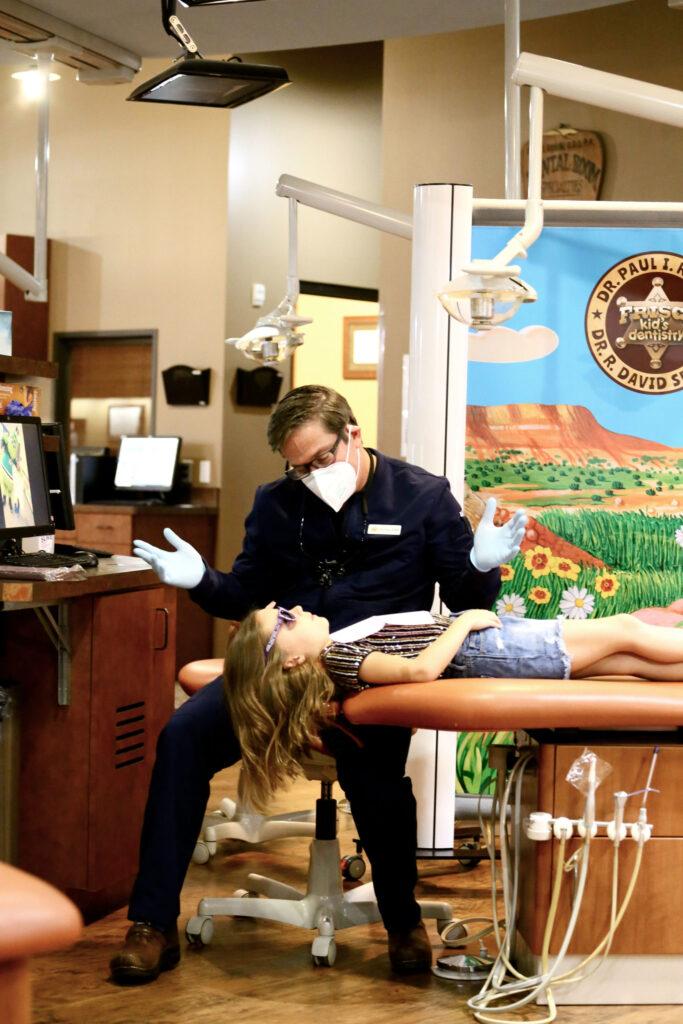Space Maintainers
When a baby tooth is lost too early, the surrounding teeth may shift, leading to space loss and complications when permanent teeth begin to erupt.
A dental space maintainer helps keep the correct spacing in your child’s mouth, ensuring proper alignment and reducing the risk of orthodontic issues in the future.
Lonestar Kid’s Dentistry provides space maintainers in Frisco, McKinney, and Prosper, TX.

Why Are Space Maintainers Necessary?
Baby teeth play a crucial role in guiding permanent teeth into their proper positions. If a primary tooth is lost too soon due to decay or injury, the adjacent teeth may shift into the empty space.
This can lead to lack of space for the incoming permanent molars, crowding, or misalignment. Space maintainers help keep the necessary space open for permanent teeth, reducing the risk of crowding or misalignment as your child’s smile develops.
Types of Space Maintainers We Offer
The best type of space maintainer depends on which tooth is missing and whether it is a single-sided (unilateral space maintainer) or involves multiple teeth.
1. Lower Lingual Holding Arch
A lower lingual holding arch is a fixed space maintainer designed to preserve space in the lower jaw when primary molars are lost.
- Used for children with mixed dentition (the stage when both baby and permanent teeth are present) to prevent space loss for multiple missing teeth.
- Consists of metal bands attached to the lower molars and a metal bar that rests behind the lower front teeth.
- Helps prevent crowding and maintains arch integrity until permanent teeth erupt.
2. Band and Loop
A loop space maintainer, also called a band and loop, is a simple, unilateral space maintainer used to hold the space of a single missing tooth.
- Features a metal band around a primary molar, with a loop that extends into the space left by the missing tooth and rests against the adjacent tooth to keep the gap open.
- Prevents adjacent teeth from shifting into the empty space.
- Commonly used when a single baby tooth is lost prematurely.
3. Distal Shoe
A distal shoe space maintainer is used when a primary molar is lost before the permanent molar has erupted.
- Made of a metal band that fits around an existing molar, with a metal extension that guides the permanent tooth into the correct position.
- Used when a child loses a primary second molar before the permanent first molar has erupted.
- Requires monitoring by a dentist to ensure proper placement as the permanent molars grow in.
4. Nance Appliance
A Nance space maintainer is used in the upper jaw to prevent molars from drifting forward.
- Features molar bands attached to the upper primary molars, with a small acrylic piece connected by a wire that rests against the roof of the mouth for stability.
- Helps maintain space and prevents forward movement of molars after early tooth loss.
- Often used for children requiring long-term space maintenance.

Placement of a Space Maintainers
A space maintainer is typically placed after the gums have healed following a tooth extraction. In some cases, it may be placed immediately if the dentist determines it is necessary.
Fixed space maintainers like band and loop, band and loop, and distal shoe are made and fitted on the same day as the tooth extraction.
Bilateral space maintainers are made custom-made in a lab. An impression or a digital scan will be taken when the tooth is extracted and sent to the lab. Your child will return for a second appointment to have the space maintainer fitted.
Caring for a Space Maintainer
A space maintainer requires a bit of extra care. Your child should:
- Avoid chewy or sticky foods that could loosen or damage it.
- Brush and floss carefully to keep the area clean.
- Avoid hard foods or objects that might bend or break it.
FAQs About Space Maintainers
A space maintainer is usually worn until the permanent tooth starts to erupt, which can take several months to a few years, depending on the child’s age and the tooth being replaced. Your dentist will monitor its progress during regular checkups.
No, space maintainers are designed to be comfortable. Your child may feel slight pressure or mild discomfort for a few days after placement, but this should go away as they get used to it.
If your child loses a baby tooth earlier than expected due to decay, injury, or extraction, a dentist will evaluate whether a space maintainer is necessary to prevent shifting and misalignment.
Yes, but they should avoid sticky or hard foods that could damage or loosen the appliance. Encourage them to eat soft, easy-to-chew foods to keep it in place and functioning properly.
Expert Pediatric Dental Care You Can Trust
Space maintainers are a simple and effective way to protect your child’s developing smile. Our experienced team at Lonestar Kid’s Dentistry provides gentle, expert care to ensure your child’s teeth stay healthy and properly aligned. Schedule a visit today to learn more about your options!
To book an appointment at our pediatric dental office in Frisco, TX call (214) 618-5200 or complete the online contact form. We are located at 6801 Warren Parkway, Suite 115, Frisco, TX.
To book an appointment at our pediatric dental office in McKinney, TX, call (214) 436-5555 or complete the online contact form. We are located at 5323 W University Dr #100 McKinney, TX.
To book an appointment at our pediatric dental office in Prosper, TX, call (469) 228-4402 or complete the online contact form. We are located at 240 S. Preston Road, Suite 10, Prosper.
Additional Resources
We are all about educating parents and kids! Check out our blog for helpful oral hygiene types. Here are a few examples of what you will find there:
